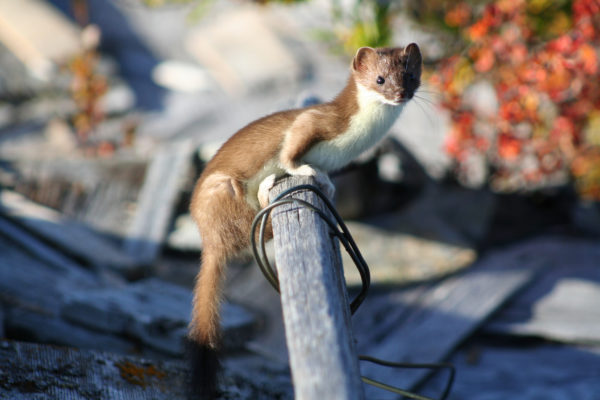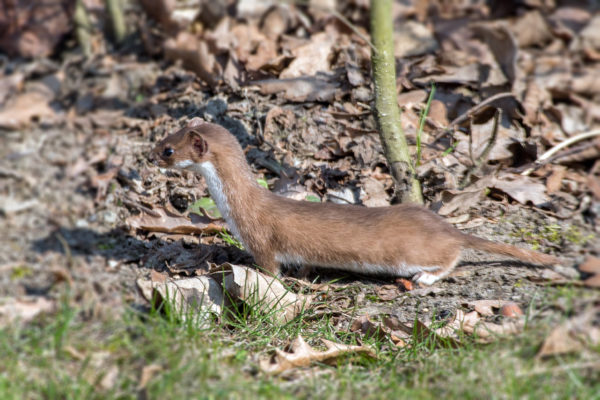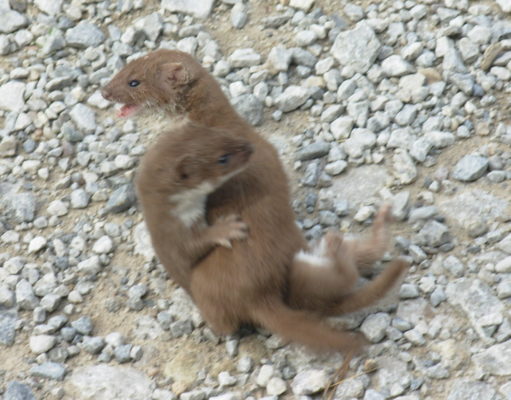Stoats tend to vie with rats for the position of Conservation Public Enemy No. 1 – but what do we know about the stoat’s smaller relative, the weasel? Do we underestimate their impact on native wildlife?
Kathryn Strang, Isabel Castro, Greg Blunden and Lara Shepherd examined the stomach contents of 16 weasels caught between 2011 and 2012 at Purerua Peninsula in the Bay of Islands in an article published recently in the New Zealand Journal of Zoology. While other mammals – including at least one mouse – were the prey group most frequently consumed, mammals weren’t the only thing the weasels were found to be eating…

Weasels appear to be locally common on Purerua Peninsula and are trapped more often than stoats.
“The weasels for this study were caught in MK6 Fenn and DOC 200 traps placed in fragmented bush at two main sites: Mataka Station and Mountain Landing… Trapping data from Purerua Peninsula show that weasels are the most captured mustelid in the area. During the time of this study, between four to seven times as many weasels were being captured for each stoat trapped. Cats are also prevalent on the peninsula, with more cats trapped than stoats in most years, and less than half as many cats captured than weasels. No ferrets were caught on the peninsula during the study.”
Once caught, the weasels were frozen until such time as their gut contents could be examined. Some were too decomposed to be of use for the study. It is a meticulous process.
“Diet was determined by analysing the gut contents. The stomachs were dissected along the greater curvature and the contents washed out. Faeces were also removed from the colon. The mixed contents from the stomach and colon from the same weasel were washed with water into a gradation of sieves (1.0 mm and 212 μm). The material remaining in the sieves was transferred to a petri dish and 95% ethanol was added to preserve the sample. These samples were examined under an Olympus S740 microscope at magnification 15× and all recognisable invertebrate or vertebrate parts were collected into separate containers for identification, with any plant material excluded.”

Then came the tricky part – identifying all those tiny bits.
“Photos of reptilian feet and bird parts were sent to experts for identification; however, they were too digested for accurate identification. Therefore, four samples (one mammal, two birds and one reptile) were identified to species level using DNA analysis at Te Papa Museum.”
Te Papa’s analysis revealed a mouse, European starling, house sparrow and copper skink.
“Mammals and invertebrates were the most common prey items in the weasels’ diet while mammals and reptiles contributed the most to dry weight. A total of five reptiles were eaten, two of which were inside the gut of one male weasel. Of the invertebrate orders consumed, Coleoptera were the most frequent (31.3%) and had a dry weight of 0.0157 g which constituted 50.6% of the total invertebrate dry weight.”
While copper skinks aren’t considered endangered, many of their similarly-sized relatives are considered threatened.
“This study shows that small mammals, reptiles, birds and invertebrates are a main component
of weasels’ diet in New Zealand, with similar results reported in other studies. Reptiles were the second most consumed vertebrate prey in this study… The highest percentage of occurrence of skinks in weasel diet previously studied was 21%. Other New Zealand studies have also found reptiles in weasel stomachs, with an occurrence frequency of 7% and 18%. These findings suggest that weasels routinely supplement their diet with reptiles, posing a larger threat to native New Zealand reptiles than previously considered.”

Birds were not a major food item, but were eaten – and a starling is a significantly-sized prey item for a weasel.
“Birds were the least consumed vertebrate prey, although bones and feathers were still found in two weasel stomachs. The two birds identified through DNA analysis were introduced species: the European starling and the house sparrow. However, these findings suggest that weasels have the capacity to hunt and kill native New Zealand birds of the same size. The average weight of an adult house sparrow is 30 g, and 85 g for a European starling. Many native and endemic New Zealand passerines are within this weight range.”
Nestlings are a particularly easy meal for predators and it seems weasels are no exception.
“Some of the birds found in the weasels’ stomachs in this study were nestlings/fledglings. Nesting birds are vulnerable to predation… These findings suggest that weasels are capable of nest predation.”
The researchers believe we may, indeed, be underestimating the threat that weasels pose to native wildlife.
“Despite its small scale, this study indicates that more research on weasels as a likely and important predator and competitor of native wildlife is needed.”
This research is published in the New Zealand Journal of Zoology. The abstract is freely available to non-subscribers.
Access to the full article can also be requested via Researchgate.

